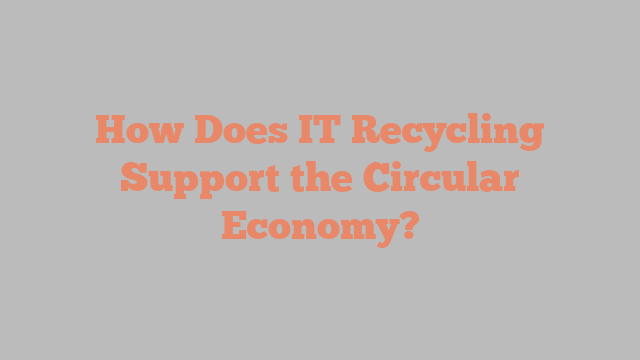Recycling Support the Circular Economy
In a linear, business-as-usual economy, materials go through an initial harvest and processing to be turned into products. The resulting products are then used and discarded. This process is illustrated by the straight line down the center of the diagram below.
In contrast, a circular economy works to keep resources in circulation by designing for reuse, repair and remanufacture. It also favors sourcing of recycled raw materials and seeks to avoid the use of fossil fuels and non-renewable resources. These strategies support economic resilience and reduce dependence on volatile global markets for raw material supplies.

Ideally, these practices are combined to minimize the use of virgin raw materials and to maximize the amount of value that is captured from each part of a product. The goal is to extend the life of a product by incorporating product design that reflects this thinking.
How Does IT Recycling Support the Circular Economy?
A key step in this effort is ensuring that used electronics are collected and treated with a minimum of impact to the environment. This can be done through a combination of individual consumer choices and public/private initiatives. For example, many cities and towns now provide labeled it recycling near me bins on sidewalks for public use and offer curbside recycling services to businesses and residents. Secondhand sales and donation are additional options for unwanted electronic equipment. However, this approach can be labor intensive and only captures a portion of the total waste stream.
The business community can also take a leading role in advancing the circular economy through partnerships and other initiatives. These include the PAAS and shared economy models, where companies allow customers to pay a fee to use their goods rather than own them outright. In this way, the company is incentivized to produce products that promote PLE and DFR and can be easily refurbished or remanufactured at the point of return.
One of the fastest growing waste streams is e-waste (electrical and digital equipment). It represents approximately 2Mt of the total global material flow each year.1 E-waste can contain toxic chemicals that are harmful to the environment and human health. The good news is that e-waste recyclers can play a crucial role in helping to minimize this challenge.
New York State laws (NYSARA and the Electronic Equipment Recycling and Reuse Act) require manufacturers to offer free e-waste recycling for most consumers. This is the foundation of a circular economy initiative that is critical to supporting the health and sustainability of local communities.
In addition to avoiding landfills and other environmental challenges, the circular economy helps to alleviate pressure on international mineral resource supply chains. This is especially true of precious metals, such as gold and platinum, which are critical to a range of high-tech products. By recycling these materials, the circular economy can help to offset a large share of the global demand for these critical resources. This also mitigates risks for the companies that source these resources, reducing their exposure to global market fluctuations and other volatility.
